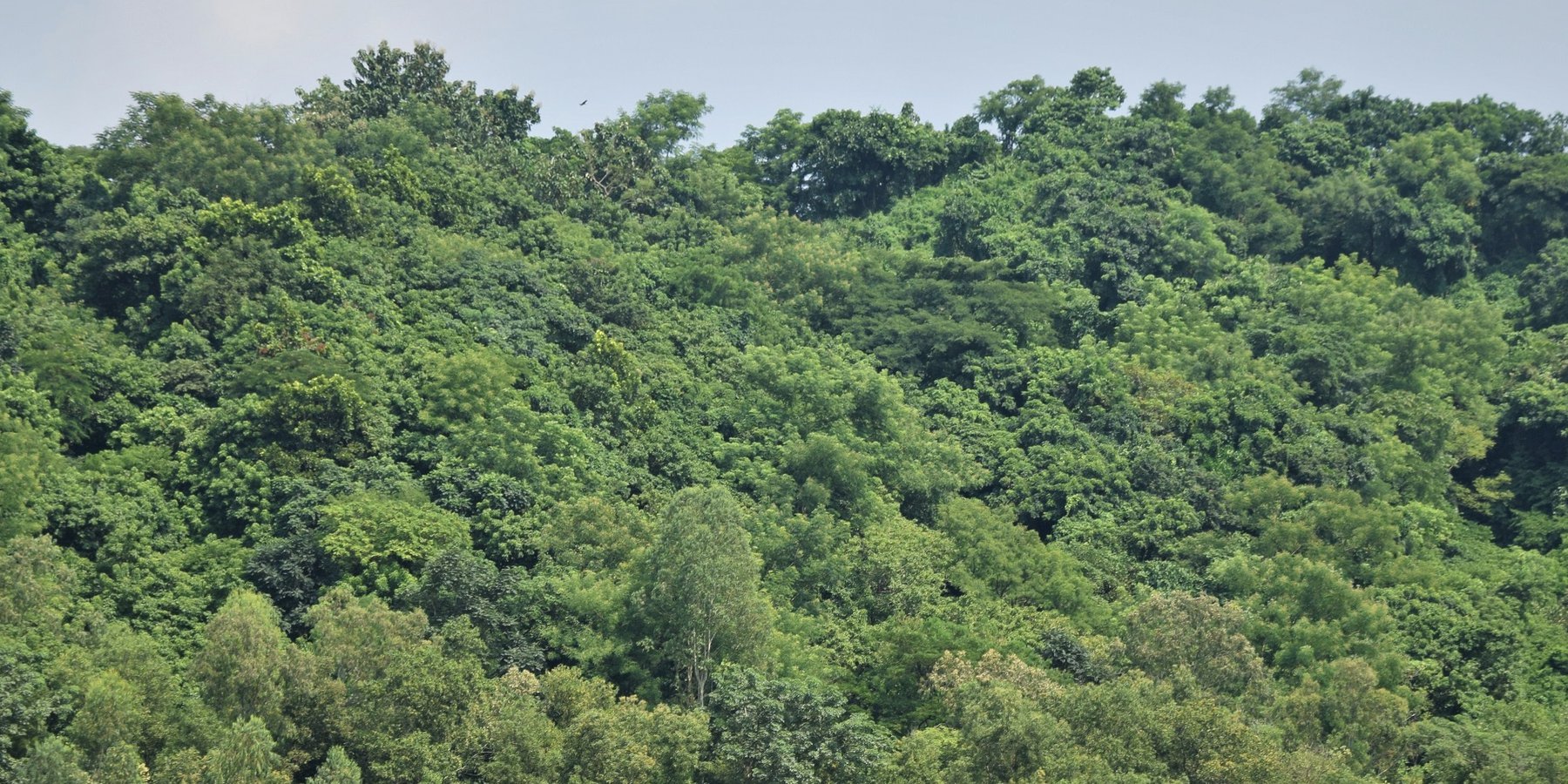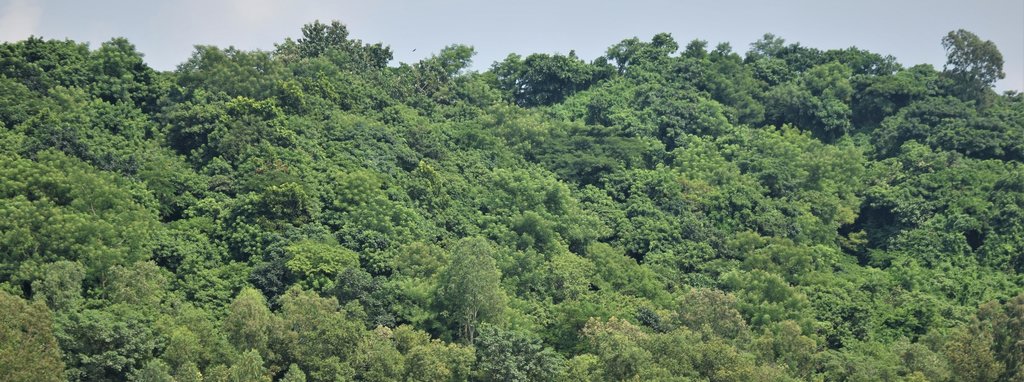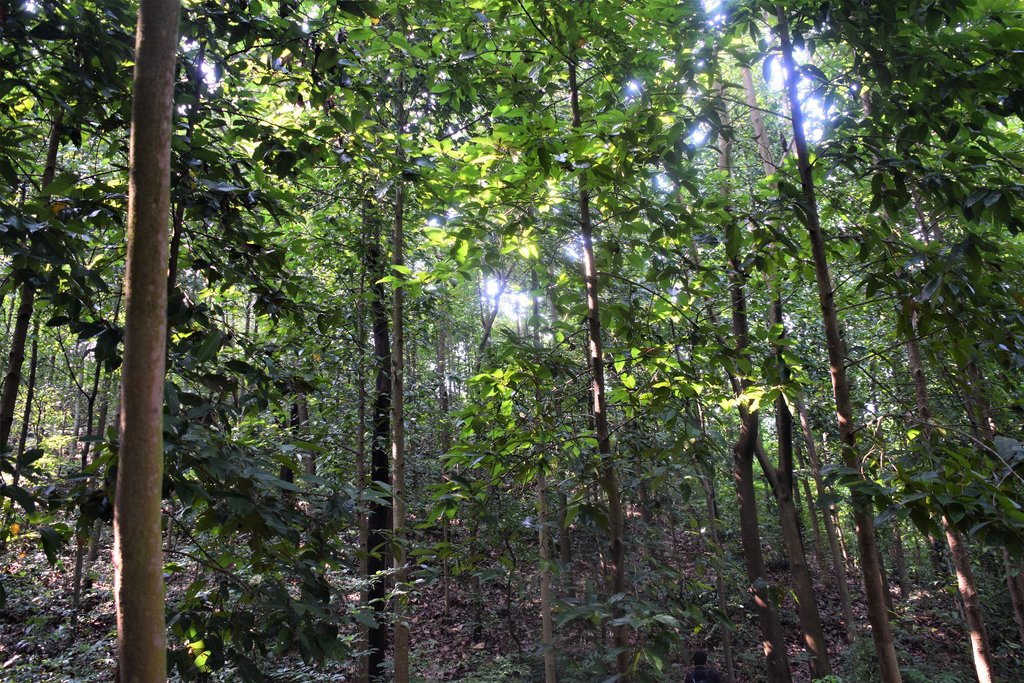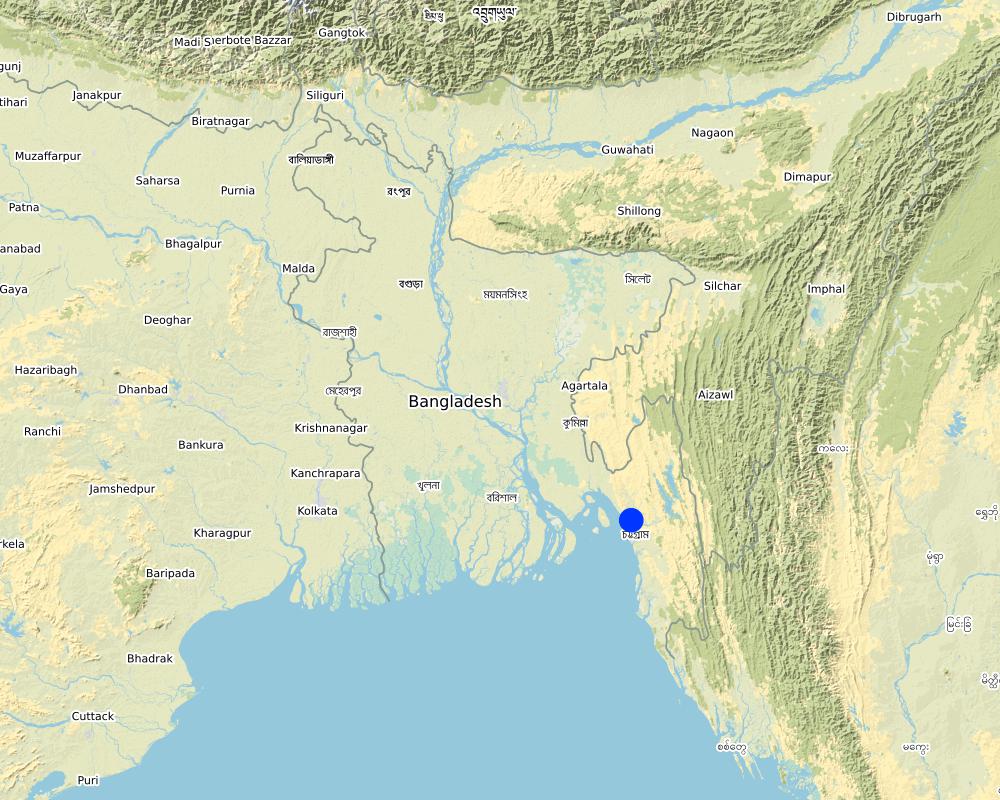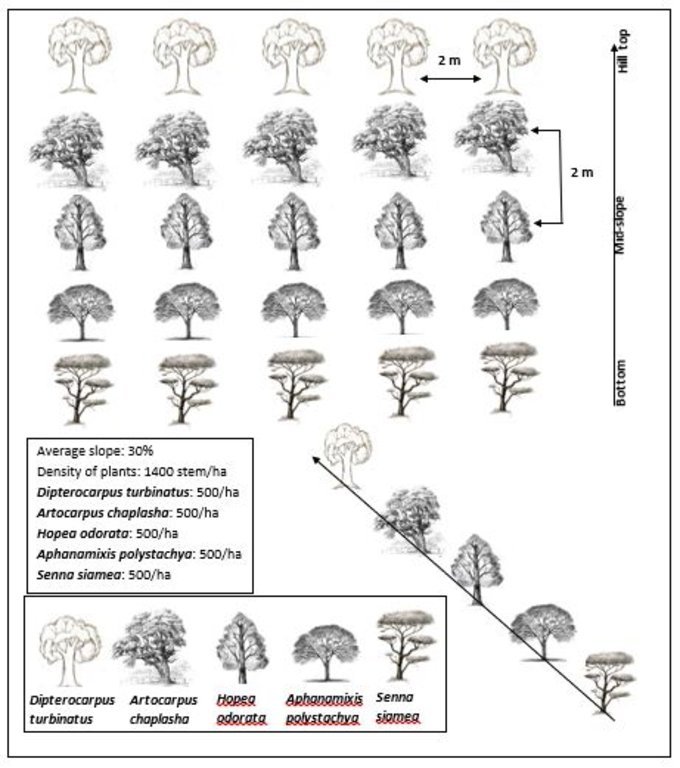Mixed plantation with slow growing indigenous species to protect land degradation [孟加拉国]
- 创建:
- 更新:
- 编制者: Fazlay Arafat
- 编辑者: –
- 审查者: Nicole Harari, Rima Mekdaschi Studer, Ursula Gaemperli
Desi Projatir Misro Bagan
technologies_4329 - 孟加拉国
查看章节
全部展开 全部收起1. 一般信息
1.2 参与该技术评估和文件编制的资源人员和机构的联系方式
关键资源人
土地使用者:
Hossain Md. Akhter
Institute of Forestry and Environmental Sciences, University of Chittagong
孟加拉国
土地使用者:
Alam Md. Bodiul
University of Chittagong
孟加拉国
有助于对技术进行记录/评估的项目名称(如相关)
Decision Support for Mainstreaming and Scaling out Sustainable Land Management (GEF-FAO / DS-SLM)有助于对技术进行记录/评估的机构名称(如相关)
Bangladesh Forest Department (Bangladesh Forest Department) - 孟加拉国1.3 关于使用通过WOCAT记录的数据的条件
编制者和关键资源人员接受有关使用通过WOCAT记录数据的条件。:
是
1.4 所述技术的可持续性声明
这里所描述的技术在土地退化方面是否存在问题,导致无法被认为是一种可持续的土地管理技术?:
否
2. SLM技术的说明
2.1 技术简介
技术定义:
Mixed plantation technique with slow growing indigenous plant species in hill slope, that plays an important role to protect land degradation.
2.2 技术的详细说明
说明:
Mixed-species plantations can play an important role in regulating land degradation and sustainable management of degraded forest areas. Among the various forestry practices, planting fast-growing species (used in mono-culture plantation) with slow-growing and indigenous species has a positive long-term impact on forest land management. Mixed species tree plantations have the potential to improve forest soils, forest cover and biological diversity, and facilitate forest succession in degraded ecosystems. In addition to carbon accumulation, mixed plantations also increase understory plant regeneration, and in some cases, reduce diseases and pests infestation in plantation. This technology is applied in hill-forest areas in Bangladesh for preventing erosion and risk of landslides, and to provide a sustainable supply of timber and fuel wood.
The plantation site located in Hathazari area of Chittagong division and inside the periphery of University of Chittagong. The landform is hill slope with 16-30% slopes on average. The annual rainfall is around 2500 mm and the soil texture is loamy to silty. The species used at the Hathazari plantation site were: Garjan (Dipterocarpus turbinatus), Telsur (Hopea odorata), Chapalish (Artocarpus chaplasha), Pithraj (Aphanamixis polystachya), and Minjiri (Senna siamea). All are deep-rooted, slow growing indigenous plant species with a felling rotation of 25-30 years. The Dipterocarpus species grows well on top of hill whereas Artocarpus chaplasha and Hopea odorata grows well in mid slope. Aphanamixis polystachya and Senna siamea perform well in bottom layer of hill. The sequence has positive mutual effects on tree growing. The plantation was established and managed by the authority of University of Chittagong (owner of the land) in 1990 with 2500 trees planted per hectare area (spacing interval 2m x 2m). The average slope of the site is around 30%. Before reforestation, the land was degraded and unproductive. As only a few scattered trees grow due to a huge demand of fuel wood the resulting insufficient coverage by tree crowns frequently led to landslides in the area. The local communities are only allowed to collect the dead branches as fuel and other non-wood forest products like honey, mushrooms, fruits and fodders from the plantation site.
The major activities required to establish the plantation are: seed collection, nursery preparation, site preparation, pit preparation, planting, tying of plants to stick for support, application of fertilizer, compost and biocide. After first establishment, the plantation needs ongoing maintenance activities such as weeding, refilling of vacancies, thinning, pruning, application of fertilizers and biocides (if necessary) and cutting of climbers. The timber species undergo a variety of thinning practices before the entire stand reaches maturity. These trees are progressively thinned out to provide fuel wood and timber, while allowing room for the natural regeneration of native species. The university authority carried out the maintenance activities and such a practice is advantageous to adjacent local communities since it meets their fuel wood demand.
Prior to establishment of the plantation, the area was barren and unproductive, and was hardly a suitable habitat for wildlife. More critically, during the annual monsoons, landslides were a regular phenomenon. The natural regeneration of the deforested area was additionally hampered by incendiary fires set by local communities for agricultural purpose. After the establishment of the plantation and the subsequent improvement of forest/land cover, it is now a habit for various species of bird, monkeys, deer, wild pigs, and rabbits. Furthermore, in humid tropical regions like Bangladesh, the frequent litterfall from indigenous plant species in mixed plantations constitutes the bulk of soil organic matter, and improved nutrient availability and soil fertility.
Though the mixed plantation required intensive management in the early stage, the example of this plantation shows that the mixed plantation with indigenous species is worthwhile and a degraded area can fully recover after 20 years. However, illicit felling of timber trees and illegal removal of litters from the ground for fuel by the local communities are still remains as a management challenge. The practice retains ecological integrity and enhances human well-being (through ‘cultural’ ecosystem services such as aesthetic beauty, ecotourism etc.) and livelihood (timber, fuelwood, non-timber forest products) as well.
2.3 技术照片
2.5 已应用该技术的、本评估所涵盖的国家/地区/地点
国家:
孟加拉国
区域/州/省:
Chittagong division
有关地点的进一步说明:
Hathazari
具体说明该技术的分布:
- 均匀地分布在一个区域
如果不知道精确的区域,请注明大致覆盖的区域:
- 0.1-1 平方千米
技术现场是否位于永久保护区?:
否
Map
×2.6 实施日期
注明实施年份:
1990
2.7 技术介绍
详细说明该技术是如何引入的:
- 在实验/研究期间
3. SLM技术的分类
3.1 该技术的主要目的
- 改良生产
- 减少、预防、恢复土地退化
- 保护生态系统
- 降低灾害风险
- 创造有益的社会影响
3.2 应用该技术的当前土地利用类型
同一土地单元内混合使用的土地::
否

森林/林地
- 植树造林
植树造林:说明树种的起源和组成:
- 混交品种
植树造林类型:
- 热带雨林人工林
- Garjan (Dipterocarpus turbinatus), Telsur (Hopea odorata), Chapalish (Artocarpus Chaplasha), Pithraj (Aphanamixis polystachya), Minjiri (Senna siamea), etc.
以上的树木是落叶树还是常绿树?:
- 混合落叶或常绿
产品和服务:
- 木材
- 薪材
- 自然保持/保护
- 娱乐/旅游
- 自然灾害防护
3.3 由于技术的实施,土地使用是否发生了变化?
由于技术的实施,土地使用是否发生了变化?:
- 是(请在技术实施前填写以下有关土地利用的问题)
同一土地单元内混合使用的土地::
否

不毛之地
具体说明:
The area was unproductive with some scatter trees that grows naturally. Due to huge demand of fuel wood the few natural stands also faced tremendous pressure. As the canopy coverage was exposed, landslides occurred frequently in that area.
3.4 供水
该技术所应用土地的供水:
- 雨养
3.5 该技术所属的SLM组
- 森林种植管理
- 改良的地面/植被覆盖
- 减少基于生态系统的灾害风险
3.6 包含该技术的可持续土地管理措施

植物措施
- V1:乔木和灌木覆盖层
3.7 该技术强调的主要土地退化类型

土壤水蚀
- Wt:表土流失/地表侵蚀
- Wg:冲沟侵蚀/沟蚀
- Wm:块体运动/滑坡
3.8 防止、减少或恢复土地退化
具体数量名该技术与土地退化有关的目标:
- 减少土地退化
4. 技术规范、实施活动、投入和成本
4.1 该技术的技术图纸
技术规范(与技术图纸相关):
The dimensions of structures are explained in the description part.
作者:
Md. Fazlay Arafat
日期:
13/09/2018
4.2 有关投入和成本计算的一般信息
具体说明成本和投入是如何计算的:
- 每个技术区域
注明尺寸和面积单位:
hectare
如果使用本地面积单位,注明转换系数为1公顷(例如1公顷=2.47英亩):1公顷=:
2.47 acres
其它/国家货币(具体说明):
BDT
如相关,注明美元与当地货币的汇率(例如1美元=79.9巴西雷亚尔):1美元=:
83.0
注明雇用劳工的每日平均工资成本:
500
4.3 技术建立活动
| 活动 | 时间(季度) | |
|---|---|---|
| 1. | Nursery preparation (seed collection, site clearing, leveling and fencing, drainage arrangement, bed preparation, making overhead shed, poly-bag preparation, potting seeds, manuring, irrigation, weed control) | October |
| 2. | Site preparation (prepare plantation site map with GPS, jungle cutting, debris collection and staging, preparation of inspection paths and fire lines) | May |
| 3. | Plantation (pit preparation, tying up of plants, application of fertilizers, compost and biocide, stick for support) | June-July |
4.4 技术建立所需要的费用和投入
| 对投入进行具体说明 | 单位 | 数量 | 单位成本 | 每项投入的总成本 | 土地使用者承担的成本% | |
|---|---|---|---|---|---|---|
| 劳动力 | Nursery work | Person day | 32.0 | 500.0 | 16000.0 | 100.0 |
| 劳动力 | Site preparation | Person day | 20.0 | 500.0 | 10000.0 | 100.0 |
| 劳动力 | Plantation | Person day | 40.0 | 500.0 | 20000.0 | 100.0 |
| 设备 | Polybags | Pieces | 3000.0 | 1.0 | 3000.0 | 100.0 |
| 设备 | Loamy soil | Cubic meter | 6.0 | 400.0 | 2400.0 | 100.0 |
| 设备 | Bamboo | Pieces | 7.0 | 600.0 | 4200.0 | 100.0 |
| 设备 | Stick | Pieces | 2600.0 | 2.0 | 5200.0 | 100.0 |
| 设备 | Rope | Lump sum | 1.0 | 200.0 | 200.0 | 100.0 |
| 设备 | Bucket, Spade, Knife | Lump sum | 1.0 | 1000.0 | 1000.0 | 100.0 |
| 植物材料 | Seeds | Kg | 2.0 | 500.0 | 1000.0 | 100.0 |
| 肥料和杀菌剂 | Urea | Kg | 12.0 | 35.0 | 420.0 | 100.0 |
| 肥料和杀菌剂 | TSP | Kg | 12.0 | 40.0 | 480.0 | 100.0 |
| 肥料和杀菌剂 | MoP | Kg | 12.0 | 30.0 | 360.0 | 100.0 |
| 肥料和杀菌剂 | Compost | Kg | 3200.0 | 4.0 | 12800.0 | 100.0 |
| 肥料和杀菌剂 | Biocide | Lump Sum | 1.0 | 200.0 | 200.0 | 100.0 |
| 施工材料 | Signboard (to demarcate plantation area, number of species planted and year of plantation) | Pieces | 1.0 | 1000.0 | 1000.0 | 100.0 |
| 技术建立所需总成本 | 78260.0 | |||||
| 技术建立总成本,美元 | 942.89 | |||||
注释:
The University of Chittagong is the land user here.
4.5 维护/经常性活动
| 活动 | 时间/频率 | |
|---|---|---|
| 1. | 1st year weeding and climber cutting | 3 times in a year |
| 2. | 2nd year weeding, climber cutting and thinning | 3 times in a year |
| 3. | 3rd year weeding, climber cutting, thinning and pruning | 3 times in a year |
| 4. | 1st year Vacancy filling, fertilizer and compost application | June-July |
| 5. | 2nd year Vacancy filling, fertilizer and compost application | June-July |
4.6 维护/经常性活动所需要的费用和投入(每年)
| 对投入进行具体说明 | 单位 | 数量 | 单位成本 | 每项投入的总成本 | 土地使用者承担的成本% | |
|---|---|---|---|---|---|---|
| 劳动力 | 1st year weeding and climber cutting | person-day | 21.0 | 500.0 | 10500.0 | 100.0 |
| 劳动力 | 2nd year weeding, climber cutting and thinning | person-day | 21.0 | 500.0 | 10500.0 | 100.0 |
| 劳动力 | 3rd year weeding, climber cutting, thinning and pruning | person-day | 12.0 | 500.0 | 6000.0 | 100.0 |
| 劳动力 | Vacancy filling, fertilizer and compost application 2 times | person-day | 30.0 | 500.0 | 15000.0 | 100.0 |
| 植物材料 | Seedlings | pieces | 500.0 | 10.0 | 5000.0 | 100.0 |
| 肥料和杀菌剂 | Urea, TSP, MoP, Compost | Lump sum | 1.0 | 1000.0 | 1000.0 | 100.0 |
| 技术维护所需总成本 | 48000.0 | |||||
| 技术维护总成本,美元 | 578.31 | |||||
4.7 影响成本的最重要因素
描述影响成本的最决定性因素:
Labor cost
5. 自然和人文环境
5.1 气候
年降雨量
- < 250毫米
- 251-500毫米
- 501-750毫米
- 751-1,000毫米
- 1,001-1,500毫米
- 1,501-2,000毫米
- 2,001-3,000毫米
- 3,001-4,000毫米
- > 4,000毫米
农业气候带
- 潮湿的
5.2 地形
平均坡度:
- 水平(0-2%)
- 缓降(3-5%)
- 平缓(6-10%)
- 滚坡(11-15%)
- 崎岖(16-30%)
- 陡峭(31-60%)
- 非常陡峭(>60%)
地形:
- 高原/平原
- 山脊
- 山坡
- 山地斜坡
- 麓坡
- 谷底
垂直分布带:
- 0-100 m a.s.l.
- 101-500 m a.s.l.
- 501-1,000 m a.s.l.
- 1,001-1,500 m a.s.l.
- 1,501-2,000 m a.s.l.
- 2,001-2,500 m a.s.l.
- 2,501-3,000 m a.s.l.
- 3,001-4,000 m a.s.l.
- > 4,000 m a.s.l.
说明该技术是否专门应用于:
- 不相关
5.3 土壤
平均土层深度:
- 非常浅(0-20厘米)
- 浅(21-50厘米)
- 中等深度(51-80厘米)
- 深(81-120厘米)
- 非常深(> 120厘米)
土壤质地(表土):
- 中粒(壤土、粉土)
土壤质地(地表以下> 20厘米):
- 中粒(壤土、粉土)
表土有机质:
- 中(1-3%)
5.4 水资源可用性和质量
地下水位表:
5-50米
地表水的可用性:
中等
水质(未处理):
不良饮用水(需要处理)
水质请参考::
地表水
水的盐度有问题吗?:
否
该区域正在发生洪水吗?:
否
5.5 生物多样性
物种多样性:
- 中等
栖息地多样性:
- 低
5.6 应用该技术的土地使用者的特征
定栖或游牧:
- 定栖的
生产系统的市场定位:
- 混合(生计/商业)
非农收入:
- 低于全部收入的10%
相对财富水平:
- 平均水平
个人或集体:
- 员工(公司、政府)
机械化水平:
- 手工作业
性别:
- 女人
- 男人
土地使用者的年龄:
- 青年人
- 中年人
5.7 应用该技术的土地使用者使用的平均土地面积
- < 0.5 公顷
- 0.5-1 公顷
- 1-2 公顷
- 2-5公顷
- 5-15公顷
- 15-50公顷
- 50-100公顷
- 100-500公顷
- 500-1,000公顷
- 1,000-10,000公顷
- > 10,000公顷
这被认为是小规模、中规模还是大规模的(参照当地实际情况)?:
- 中等规模的
5.8 土地所有权、土地使用权和水使用权
土地所有权:
- 州
土地使用权:
- 个人
用水权:
- 自由进入(无组织)
土地使用权是否基于传统的法律制度?:
否
5.9 进入服务和基础设施的通道
健康:
- 贫瘠
- 适度的
- 好
教育:
- 贫瘠
- 适度的
- 好
技术援助:
- 贫瘠
- 适度的
- 好
就业(例如非农):
- 贫瘠
- 适度的
- 好
市场:
- 贫瘠
- 适度的
- 好
能源:
- 贫瘠
- 适度的
- 好
道路和交通:
- 贫瘠
- 适度的
- 好
饮用水和卫生设施:
- 贫瘠
- 适度的
- 好
金融服务:
- 贫瘠
- 适度的
- 好
6. 影响和结论性说明
6.1 该技术的现场影响
社会经济效应
生产
木材生产
森林/林地质量
非木材林业生产
注释/具体说明:
honey, mushrooms and fruits for wildlife
生产故障风险
注释/具体说明:
mixed plantation is more pest resistant
产品多样性
注释/具体说明:
Along with timber these mixed plantation yields oil, fruits, fodder, fuel and herbal medicines
生产区域
土地管理
注释/具体说明:
The degraded land which was vulnerable for landslides now convert to a native plantation area
水资源可用性和质量
灌溉用水的可用性
注释/具体说明:
Increase of the stream flow that used for irrigation in adjacent crop lands
灌溉用水的质量
收入和成本
收入来源的多样性
注释/具体说明:
tourism promoted in the area
工作量
注释/具体说明:
The workload increased at the initial stage but in the long run it will protect from the hassle of landslides
社会文化影响
土地使用权/用水权
娱乐机会
注释/具体说明:
tourism increased in the area
SLM/土地退化知识
生态影响
水循环/径流
水量
注释/具体说明:
water holding capacity of soil increased due to the increase organic matter in the soil and canopy coverage
水质
地表径流
多余水的排放
地下水位/含水层
注释/具体说明:
aquifer recharge positively influenced due to the canopy coverage and reduction of surface runoff
土壤
土壤水分
土壤覆盖层
土壤流失
土壤堆积
养分循环/补给
土壤有机物/地下C
生物多样性:植被、动物
植被覆盖
生物量/地上C
植物多样性
外来入侵物种
注释/具体说明:
as the plantation established and maintained with native plant species, the alien invasive plant species are not able to spread much here
动物多样性
有益物种
栖息地多样性
注释/具体说明:
The before bare, unproductive and degraded land now supports habitat for various wildlife
害虫/疾病控制
减少气候和灾害风险
滑坡/泥石流
飓风、暴雨的影响
碳和温室气体的排放
风速
6.2 该技术的场外影响已经显现
水资源可用性
旱季稳定可靠的水流
下游淤积
注释/具体说明:
downstream siltation decreased due to reduction of surface runoff
温室气体的影响
6.3 技术对渐变气候以及与气候相关的极端情况/灾害的暴露和敏感性(土地使用者认为的极端情况/灾害)
渐变气候
渐变气候
| 季节 | 增加或减少 | 该技术是如何应对的? | |
|---|---|---|---|
| 年温度 | 增加 | 好 | |
| 年降雨量 | 减少 | 好 | |
| 季雨量 | 湿季/雨季 | 增加 | 好 |
气候有关的极端情况(灾害)
生物灾害
| 该技术是如何应对的? | |
|---|---|
| 昆虫/蠕虫侵扰 | 好 |
6.4 成本效益分析
技术收益与技术建立成本相比如何(从土地使用者的角度看)?
短期回报:
轻度消极
长期回报:
非常积极
技术收益与技术维护成本/经常性成本相比如何(从土地使用者的角度看)?
短期回报:
轻度消极
长期回报:
积极
6.5 技术采用
- 1-10%
在所有采用这项技术的人当中,有多少人是自发的,即未获得任何物质奖励/付款?:
- 91-100%
6.6 适应
最近是否对该技术进行了修改以适应不断变化的条件?:
否
6.7 该技术的优点/长处/机会
| 土地使用者眼中的长处/优势/机会 |
|---|
| This practice reduces 80% of landslides in this area. |
| Increases the soil fertility of the degraded land through improved nutrient cycling. |
| Enhances biodiversity conservation through habitat improvement. |
| 编制者或其他关键资源人员认为的长处/优势/机会 |
|---|
| Increase carbon sequestration |
| Provide a sustainable source of fuel wood and timber to the land user |
6.8 技术的弱点/缺点/风险及其克服方法
| 土地使用者认为的弱点/缺点/风险 | 如何克服它们? |
|---|---|
| Protecting mixed-species plantations from illicit felling is difficult | Regular patrolling need to be introduced |
| Silvicultural practices like thinning and pruning are not systematically practiced as local community collect dead branches for fuel | |
| Local community collect litter from the ground to meet their fuel demand and this reduces the soil fertility | Collecting litter from ground should be banned to protect soil fertility |
| 编制者或其他关键资源人员认为的弱点/缺点/风险 | 如何克服它们? |
|---|---|
| Due to the slow-growing nature of indigenous plant species, there is a long lag period before harvest gets possible (which has impacts on income). | Alternate income generation activity need to be introduced |
7. 参考和链接
7.1 信息的方法/来源
- 实地考察、实地调查
Number of informants were five including the plantation co-coordinator and plantation monitoring officer.
- 与土地使用者的访谈
Interview of four land user
- 与SLM专业人员/专家的访谈
One professor and one assistant professor of forestry discipline.
(现场)数据是什么时候汇编的?:
11/09/2018
7.4 一般注释
The questionnaire addressed all the specifications of the technology
链接和模块
全部展开 全部收起链接
无链接
模块
无模块


